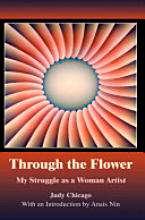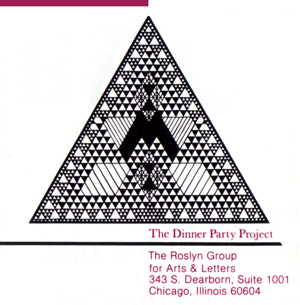
The story begins with The Roslyn Group… click on titles to jump to sections – About The Roslyn Group for Arts and Letters – About The Roslyn Group for Arts and Letters They were a group of women meeting monthly in a literary salon at the home of Diann DeWeese Smith at 714 Roslyn Place in Chicago to discuss women’s literature and issues. Together, they read Judy Chicago’s Through the Flower: My Struggle as a Woman Artist telling of The Dinner Party, an exhibition that challenged the myth surrounding and narrowly defining women’s experience. Anne Marie Lipinski, a cub reporter for the Chicago Tribune had just published the article, Public May Never Again Feast on Paean to Women, in August 1979, after the closing of The Dinner Party exhibition in San Francisco. The group invited Lipinski to speak at the Roslyn Group meeting.After learning about the difficulties Judy Chicago encountered in finding a venue for The Dinner Party exhibition in other cities, and learning that the Art Institute of Chicago had already turned it down, the group decided to approach other institutions to bring the feminist-focused art piece to the hometown Judy had taken as her last name. The women’s movement in Chicago during this period (see TIMELINE) was progressive and promising, so it seemed a local museum would welcome the exhibit. Jane Byrne had just been elected by a five-to-one margin, giving Chicago, the “Second City” in America, the distinction of a female mayor. The Dinner Party exhibition was already acclaimed by attendance-shattering crowds across the country. Surely, it was timely and appropriate that Chicago host the exhibition. “I cannot tell you that I’ll like it. But I'm guaranteeing my right to see it.” Led by Jean Hunt, assistant professor of history at Loop College (now Harold Washington College), and Mary Houghton, executive vice president of South Shore Bank, the group offered assistance to Chicago institutions which might have been expected to exhibit the museum-quality sculpture. As Jean Hunt recalls “Women had been written out of history. And we were determined to write them back in.” After the Art Institute of Chicago declined for the second time, the Museum of Contemporary Art and the Chicago Cultural Center showed interest, but the physical space requirement for the piece could not be met. The Roslyn Group explored a collaboration with Columbia College and Navy Pier. The exhibition was considered controversial and gathered criticism as well as praise (see Critical Response in sidebar on next page). When institutions failed to respond to their proposals, The Roslyn Group chose to host The Dinner Party exhibition themselves. – Forming The Dinner Party Project in Chicago Steering Committee Realizing the daunting task—no venue, no institutional support, no backing—The Roslyn Group tapped their first and strongest resource: the networks of their women colleagues; and in 1979 held a public meeting at the Chicago Public Library (now the Chicago Cultural Center) to gauge interest and commitment. An ad hoc committee formed, and from there, a call went out to women in all fields throughout Chicago. TheDinner Party Project in Chicago Steering Committee was formed to begin the work of finding an exhibit space, raising the funds, hiring staff, recruiting volunteers, and generating interest and support. Over the course of two years, meeting every Tuesday, The Dinner Party Project in Chicago grew from a handful of women from The Roslyn Group for Arts and Letters, into a Steering Committee, Finance Committee, Fundraising Committee, paid Staff, plus an Advisory Board (see list at right). The Roslyn Group for Arts and Letters incorporated in 1981 to become the fiscal agent to bring Judy Chicago’s The Dinner Party exhibition to Chicago. “The project was conceived by a Jewish feminist with the help of Catholic nuns, the Ecclesiastical Stitchers Guild, Methodist, Baptist and Episcopalian china-painters, and literally scores of researchers and studio assistants. It is a non-traditional work of art created with very traditional techniques. With deliberate irony, Chicago was utilizing ‘women’s techniques’ (stitchery and china painting) in a ‘woman’s context’ (The Dinner Party) to create a major feminist art statement.”
—Jan Butterfield, Mother Jones (January 1979) The Dinner Party also reaches across all gender and historic limitations to offer universal impact and exciting possibilities for attitudinal change. Judy Chicago has said, “I believe art has an incredible capacity to illuminate reality, bring a new perspective, bridge gaps.” Many Roslyn Group members have worked together — across economic, racial, religious and age lines — since the early days of the Civil Rights Movement of the 60’s and throughout the Women’s Movement of the 70’s. The brilliance of Judy Chicago’s concept of unearthing and illuminating women’s lost history — and the excellence of its execution by innovative artisans challenged Roslyn Group volunteers to be equally inspired. Another chapter of our history of work together has been written. Our trust and pride in one another abounds. —Diann DeWeese Smith (from the program for The Dinner Party Project in Chicago, 1981) — Alumnae featured in video clips Thirty years later, in May 2011, alumnae for the Dinner Party Project in Chicago met to reflect and share their experiences. After a trip in to see the long-term installation of The Dinner Party exhibition at the Brooklyn Museum in 2007, members of the group felt that the historical record was not complete without the story of the extraordinary community effort that the women of Chicago put forth to bring the project to their city. They wanted to provide a model for other groups who hosted the exhibit to include their communities in the history of The Dinner Party exhibition. And they wanted to inspire a new generation to attempt and implement bold plans. The full video tape from this two-day 30-year anniversary memoir workshop is housed at the The Dinner Party Project in Chicago archives at the University of Illinois.
Visit the Timeline page to find out how you can be part of history!
|



